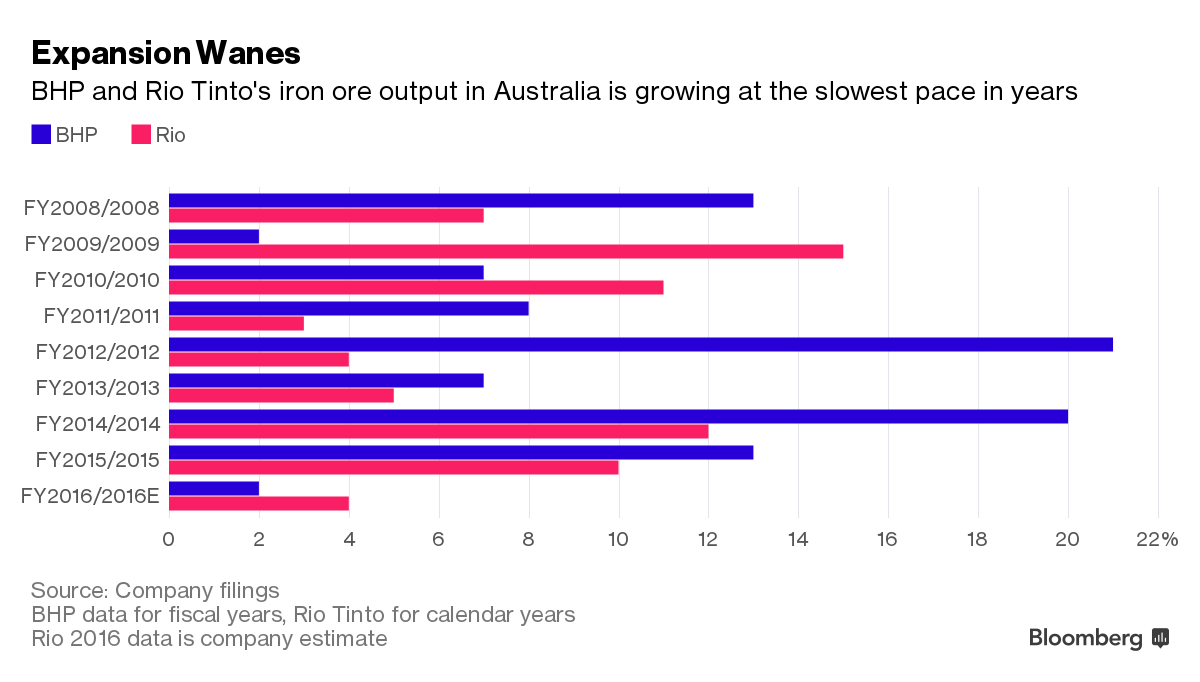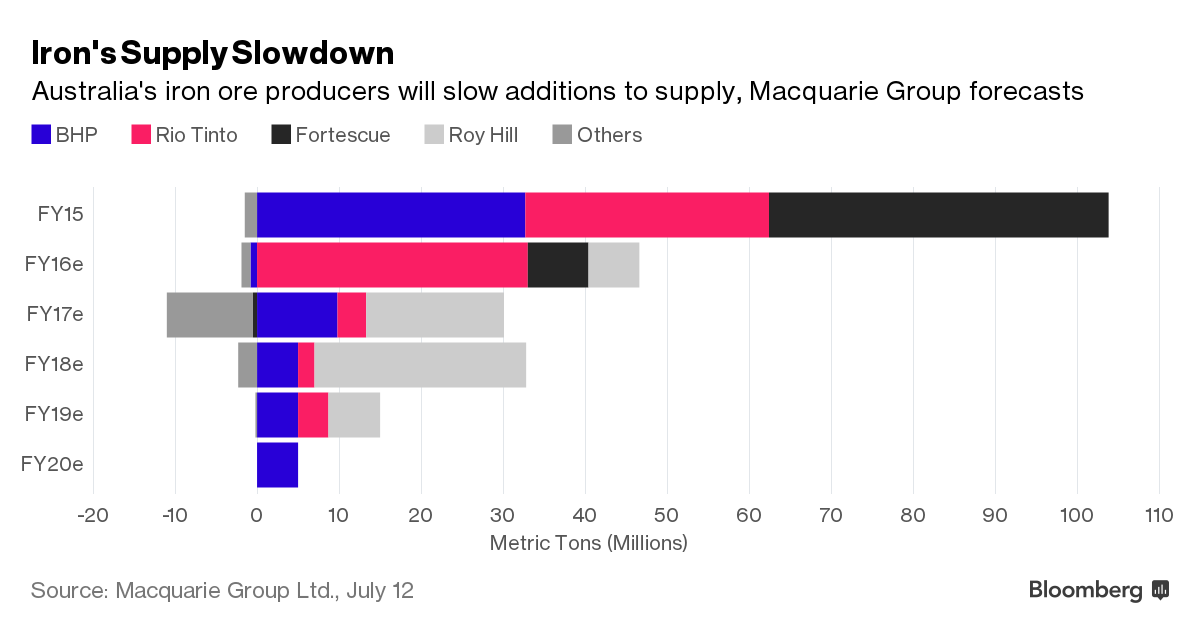End of Australia’s Iron Ore Supply Rush Seen Aiding Prices
The largest iron ore producers in Australia, the world’s No. 1 exporter, are raising supply at the slowest pace in years, drawing a line under more than a decade of expansions and lending potential support to prices that are rebounding this year.
BHP Billiton Ltd., the third-largest shipper, said Wednesday total output from its Western Australian mines may increase as little as 3 percent over the next 12 months after notching a 2 percent gain in the year ended June 30, the smallest annual jump since fiscal 2009. Rio Tinto Group’s shipments this calendar year are seen expanding at the weakest rate since 2012.

Iron ore has advanced 28 percent this year to rebound from three straight annual declines after policymakers in China pledged to bolster growth. The world’s second-biggest economy churned out a record daily amount of steel in June as mills boosted supply to take advantage of the rebound in prices.
Restraint from Australia’s biggest iron ore exporters could “certainly help prices in the short term, over the next two years,” Caue Araujo, a principal consultant at SRK Consulting said by phone from Perth. “The supply side is sending a message that you shouldn’t expect supply to grow by that much, that we shouldn’t expect any surprises on the supply side in the next couple of years.”
Iron ore futures advanced 0.8 percent to 426.5 yuan ($63.87) a metric ton Thursday on the Dalian Commodity Exchange at 11:02 a.m. in Sydney.
Global trade in iron ore may grow 4 percent in 2017 as exported material continues to displace higher-cost domestic supply in China, according to Australia’s Department of Industry, Innovation and Science. China’s iron ore imports may rise about 2 percent to 974 million metric tons this year and by 0.7 per cent to 981 million tons in 2017, the department said in a report published earlier this month.
Australia’s two top suppliers may be adjusting the addition of new supply to accommodate weaker market conditions, Morgan Stanley analysts including Tom Price said last month, as the bank raised its iron ore outlook for this year and 2017.
Tempering Supply
A 24-month campaign of rail maintenance begun this year by BHP will crimp some output growth as the company strives to complete a program to reach a potential 290 million tons a year capacity in Western Australia, while Rio is having difficultiescompleting an autonomous train program that will help to raise annual shipments to 360 million tons. Rio’s work will limit output growth in 2017, the producer reiterated Tuesday.
Both BHP and Rio may have peak production rates that fall short of those capacity targets, Macquarie Group Ltd. analysts wrote in a July 12 note.
“It does seem at the margin that they are tempering supply and that clearly reflects the price,” Peter O’Connor, a Sydney-based analyst with Shaw and Partners Ltd., said by phone. “Their expansions have run their course, and though it may take them two or three years to top out we are now on the plateau of that curve.”
Fortescue Metals Group Ltd., Australia’s No. 3 supplier, has pledged to hold annual output to around 165 million tons, though reported last week full-year shipments of 169.4 million tons, citing mild weather that meant it experienced fewer-than-expected disruptions.
For a Gadfly commentary about Australia’s iron ore expansions, click here.
Continued supply growth from larger exporters will put pressure on prices in the medium term, as will the return of some marginal producers to the export market in response to the material’s price spike earlier this year, Citigroup Inc. analysts said last week. Prices may decline to $42 a metric ton in 2017 and to $38 a ton in 2018, the analysts wrote. Iron ore prices remain about 70 percent lower than a 2011 peak.
Brazil’s Vale SA and billionaire Gina Rinehart’s Roy Hill Holdings Pty are among producers likely to bring about 60 million tons of new capacity online this year and deliver a further 50 million tons in 2017, Citigroup said in its note. Exports from Australia and Brazil will rise to about 1.3 billion tons by 2017, accounting for 86 percent of the seaborne market, the Australian industry department said.

“The reality is that we need to see some much larger supply declines over the coming five to 10 years to bring the market back into balance and to see the price rise further,” Romano Sala Tenna, a portfolio manager at Katana Asset Management Ltd. said by phone from Perth. Slower supply growth by BHP and Rio is “a little bit too little, too late,” he said. Ore with 62 percent content delivered to Qingdao declined for a sixth straight session Wednesday, falling 0.5 percent to $55.75 a dry metric ton, according to Metal Bulletin Ltd. data.
By the end of the decade, the rate of supply growth from Western Australia’s Pilbara iron ore region is forecast to dwindle, according to Macquarie Group, which calculates less than 20 million tons will be added in the two years to July 2019.
“The focus is on efficiency and costs and not on adding tons, and that’s a good sign,” according to SRK’s Araujo. “It’s about making more money per ton, rather than about increasing tons.”
Source: Bloomberg
HEADLINES
- Do shipping markets want Biden or Trump for the win?
- All 18 crew safe after fire on Japanese-owned tanker off Singapore
- Singapore launching $44m co-investment initiative for maritime tech start-ups
- Cosco debuts Global Shipping Industry Chain Cooperation Initiative
- US warns of more shipping sanctions
- China continues seaport consolidation as Dalian offer goes unconditional